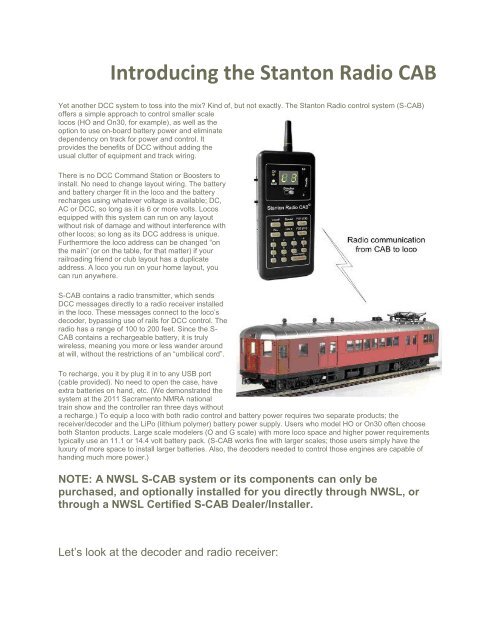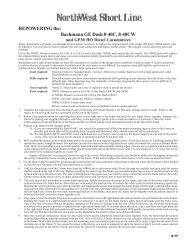Introducing the Stanton Radio CAB
Introducing the Stanton Radio CAB
Introducing the Stanton Radio CAB
Create successful ePaper yourself
Turn your PDF publications into a flip-book with our unique Google optimized e-Paper software.
<strong>Introducing</strong> <strong>the</strong> <strong>Stanton</strong> <strong>Radio</strong> <strong>CAB</strong><br />
Yet ano<strong>the</strong>r DCC system to toss into <strong>the</strong> mix? Kind of, but not exactly. The <strong>Stanton</strong> <strong>Radio</strong> control system (S-<strong>CAB</strong>)<br />
offers a simple approach to control smaller scale<br />
locos (HO and On30, for example), as well as <strong>the</strong><br />
option to use on-board battery power and eliminate<br />
dependency on track for power and control. It<br />
provides <strong>the</strong> benefits of DCC without adding <strong>the</strong><br />
usual clutter of equipment and track wiring.<br />
There is no DCC Command Station or Boosters to<br />
install. No need to change layout wiring. The battery<br />
and battery charger fit in <strong>the</strong> loco and <strong>the</strong> battery<br />
recharges using whatever voltage is available; DC,<br />
AC or DCC, so long as it is 6 or more volts. Locos<br />
equipped with this system can run on any layout<br />
without risk of damage and without interference with<br />
o<strong>the</strong>r locos; so long as its DCC address is unique.<br />
Fur<strong>the</strong>rmore <strong>the</strong> loco address can be changed “on<br />
<strong>the</strong> main” (or on <strong>the</strong> table, for that matter) if your<br />
railroading friend or club layout has a duplicate<br />
address. A loco you run on your home layout, you<br />
can run anywhere.<br />
S-<strong>CAB</strong> contains a radio transmitter, which sends<br />
DCC messages directly to a radio receiver installed<br />
in <strong>the</strong> loco. These messages connect to <strong>the</strong> loco’s<br />
decoder, bypassing use of rails for DCC control. The<br />
radio has a range of 100 to 200 feet. Since <strong>the</strong> S-<br />
<strong>CAB</strong> contains a rechargeable battery, it is truly<br />
wireless, meaning you more or less wander around<br />
at will, without <strong>the</strong> restrictions of an “umbilical cord”.<br />
To recharge, you it by plug it in to any USB port<br />
(cable provided). No need to open <strong>the</strong> case, have<br />
extra batteries on hand, etc. (We demonstrated <strong>the</strong><br />
system at <strong>the</strong> 2011 Sacramento NMRA national<br />
train show and <strong>the</strong> controller ran three days without<br />
a recharge.) To equip a loco with both radio control and battery power requires two separate products; <strong>the</strong><br />
receiver/decoder and <strong>the</strong> LiPo (lithium polymer) battery power supply. Users who model HO or On30 often choose<br />
both <strong>Stanton</strong> products. Large scale modelers (O and G scale) with more loco space and higher power requirements<br />
typically use an 11.1 or 14.4 volt battery pack. (S-<strong>CAB</strong> works fine with larger scales; those users simply have <strong>the</strong><br />
luxury of more space to install larger batteries. Also, <strong>the</strong> decoders needed to control those engines are capable of<br />
handing much more power.)<br />
NOTE: A NWSL S-<strong>CAB</strong> system or its components can only be<br />
purchased, and optionally installed for you directly through NWSL, or<br />
through a NWSL Certified S-<strong>CAB</strong> Dealer/Installer.<br />
Let’s look at <strong>the</strong> decoder and radio receiver:
Quarter not included, but this gives you an idea on size. There are actually three separate items in this photo,<br />
although what’s pictured is one option for how we build and ship <strong>the</strong>se things. The circuit board on top is <strong>the</strong> radio<br />
receiver. The blue vertical rectangle on <strong>the</strong> left side is <strong>the</strong> antenna. Under <strong>the</strong> radio board (and secured by <strong>the</strong> white<br />
shrink wrap tape) is <strong>the</strong> DCC decoder, which in this photo is an North Coast Engineering (NCE) decoder. Initially, we<br />
offer a choice of two decoders, NCE (excellent decoder, lowest cost, no sound) or a SoundTraxx Tsunami(R)<br />
decoder (an excellent sound decoder.)<br />
When buying an S-<strong>CAB</strong> system, you select <strong>the</strong> decoder, and tell us how you’d like <strong>the</strong> antenna mounted. What we<br />
ship you is <strong>the</strong>n a bundle (decoder+radio receiver+antenna) such as <strong>the</strong> one pictured above, plus instructions, and<br />
that’s what you install in your engine. The controller itself is ready to go. In a nutshell, you install <strong>the</strong> decoder, turn on<br />
<strong>the</strong> controller, give <strong>the</strong> decoder an address (standard DCC fare), provide power ei<strong>the</strong>r from a battery or <strong>the</strong> track, and<br />
start sending commands to that address. You only need one controller (included with your starter bundle) and from<br />
<strong>the</strong>re it’s just additional radio+decoder+antenna assemblies as needed.<br />
Are <strong>the</strong>re drawbacks here? We don’t really think so, but <strong>the</strong>re are some limitations. The design goal for <strong>the</strong> S-<strong>CAB</strong><br />
was to create an inexpensive, simple, and straightforward wireless control system for those that want DCC<br />
functionality (and/or battery power) without having to mess with layout wiring or install DCC equipment. That said, <strong>the</strong><br />
S-<strong>CAB</strong> is not recommended for large club layouts, which generally have a large investment in DCC operation to<br />
support many operators. The S-<strong>CAB</strong> is intended for use by one or two operators, running up to 15 locos during an<br />
operating session. It’s a quick, mobile way of controlling <strong>the</strong> action and it does not really matter what layout is <strong>the</strong> site<br />
of <strong>the</strong> action. You run your locos with your S-<strong>CAB</strong> independent of how <strong>the</strong> layout is wired and controlled without<br />
interference to o<strong>the</strong>r operators. Any likelihood of radio interference is minimized, since <strong>the</strong> S-<strong>CAB</strong>’s radio transmitter<br />
turns on only for <strong>the</strong> 0.035 seconds required to send <strong>the</strong> DCC message. For extra reliability, <strong>the</strong> command is<br />
repeated 4 times during this brief radio transmission.<br />
The <strong>Stanton</strong> <strong>CAB</strong> was designed by Neil <strong>Stanton</strong>, designer of <strong>the</strong> <strong>Stanton</strong> Drive self-powered truck. (In fact, <strong>the</strong> two<br />
work really well toge<strong>the</strong>r.) It follows NMRA standards to <strong>the</strong> letter; NWSL is proud to offer this quality product.<br />
Support and general discussion is available through <strong>the</strong> Yahoo! group set up specifically for <strong>the</strong> drive, which can be<br />
accessed at http://groups.yahoo.com/group/S-<strong>CAB</strong>. (Please note; membership to this list is restricted to S-<strong>CAB</strong><br />
owners only.)<br />
As always, thanks for looking, and we’ll do what we can to keep you updated with new developments.
Additional photos:<br />
The S-<strong>CAB</strong> controller. This is all you need to control your locos. No base station, no signals sent<br />
through <strong>the</strong> track.<br />
Bill's V&T C-17 with S-<strong>CAB</strong> and battery installed in <strong>the</strong> tender.
Justin's HO scale Goose with <strong>the</strong> S-<strong>CAB</strong> installed. With <strong>the</strong> extra room, we could get three cells in this one.<br />
Justin's HOn3 K-27 with an S-<strong>CAB</strong> system, including battery, in <strong>the</strong> tender.
Ano<strong>the</strong>r view of Justin's HOn3 K-27, with <strong>the</strong> decoder and radio in <strong>the</strong> tender.<br />
PLEASE NOTE: <strong>Stanton</strong> S-<strong>CAB</strong> starter kits, additional decoders, and battery products are built and sold by NWSL<br />
certified installers (CI) only!<br />
A list of authorized NWSL CI’s can be found above. (Folks, this list is going to take a while to populate so thanks in<br />
advance for your patience.)<br />
Copyright © 2009 Oso Railworks, Inc. All Rights Reserved.



